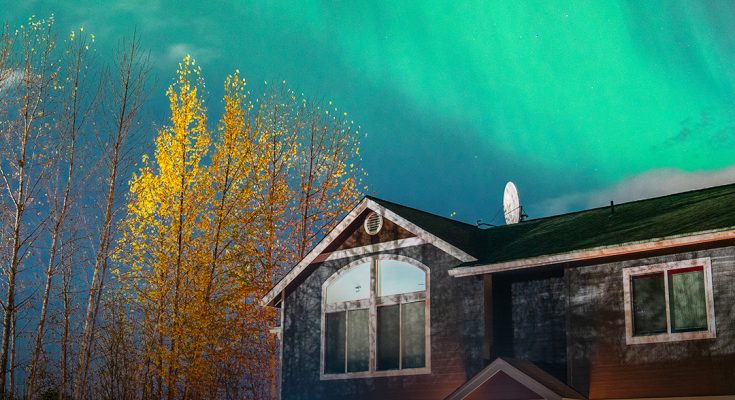The Space Weather Prediction Center (SWPC) recently shared information concerning the potential aurora borealis displays over North America on Thanksgiving and Black Friday. Their data indicates the view line showing the southernmost locations where the aurora might be visible on the northern horizon, and the predicted intensity of the light spectacle.

The night sky in Wisconsin glows with the Northern Lights in 2024. | Source: Getty Images
To calculate the projection, the SWPC uses the OVATION model, which stands for “Oval Variation, Assessment, Tracking, Intensity, and Online Nowcasting.” This empirical model indicates the “intensity of the aurora.”

The Northern Lights seen over Wisconsin in 2024. | Source: Getty Images
According to the SWPC, “The model uses maximum forecast geomagnetic activity (Kp) between 6pm and 6am US Central Time [sic]” for tonight and tomorrow evening (November 28 and 29).
The organization issued a geomagnetic storm watch for both days on November 26, due to the arrival of a coronal mass ejection (CME) “associated with a filament eruption that took off the Sun late on” November 25.
Two images of a map, which are subject to continuous updates, display where the aurora is most likely to occur. According to the map’s view line, Washington, Montana, North Dakota, Minnesota, Wisconsin, Michigan, and Maine are the states likely to witness the aurora.

An illustration of a map of the U.S. created in 2019. | Source: Getty Images
The northern regions of Idaho, Vermont, New Hampshire, and New York are within the aurora view line as well. In the images, the aurora’s brightness and location are typically indicated by a “green oval centered on Earth’s magnetic pole.” When the Northern Lights are expected to increase in intensity, the green oval changes to red.
Although the aurora is not visible during daylight hours, the light spectacle can be observed just before sunrise or just after sunset. The SWPC also clarifies that the Northern Lights “can be observed from as much as 1000 [sic] km away when the aurora is bright and if conditions are right.”

The Northern Lights above North of Vaasa, western Finland on October 11, 2024 | Source: Getty Images
In addition to providing data, the SWPC shared tips for viewing. Regarding the matter of location, the weather prediction center suggests that people head toward the magnetic poles.
Currently located in the islands of northeast Canada approximately 400 km (250 miles) from the geographic pole is the north magnetic pole.

The Northern Lights in London, Ontario (Canada) on May 10, 2024 | Source: Getty Images
Given that this is the case, the SWPC suggests finding a place “where you can see to the north (or south if you are in the southern hemisphere).”
Additionally, if individuals can find the right unobstructed vantage point, like on top of a hill in the northern hemisphere, they will be able to see the aurora “when it is 1000 [sic] km (600 miles) further north.”

A photographer takes pictures of aurora borealis in Rileyville, Virginia on October 10, 2024 | Source: Getty Images
Clear aurora displays can also be viewed by people who are in “the right place under the aurora” even if the geomagnetic activity is as low as Kp 3 or 4.
Another viewing tip posed by the SWPC is for people to go to viewing locations at night and move away from city lights because the full moon will already diminish the apparent brightness of the aurora, but not its actual brightness.

The Northern lights seen over Washington, DC on October 10, 2024 | Source: Getty Images
The SWPC also urges civilians to remember that “the high latitudes where aurora occur are also latitudes where it doesn’t get dark in the summer.”
This means that people who seek to combine plans for a summer vacation with traveling to the Arctic to watch the aurora will not be successful, as the spectacle will only be visible when it’s dark.

The Northern Lights displayed over Svolvaer, Norway on July 3, 2024 | Source: Getty Images
Last, but certainly not least, the SWPC advises on the exact best times to witness the Northern Lights. “Best aurora is usually within an hour or two of midnight (between 10 PM and 2 AM local time [sic]). These hours of active aurora expand towards evening and morning as the level of geomagnetic activity increases,” explains the SWPC.

The Northern Lights illuminate the skies in Brandenburg, Lietzen on October 10, 2024 | Source: Getty Images
However, they also note that while aurora may be present in the evening and morning, it is typically not as active and thus, less visually appealing. Regarding the best seasons to witness the Northern Lights, the weather center says the spring and fall equinoxes are ideal.

The aurora borealis displayed over Haraldsted Lake, Denmark on October 10, 2024 | Source: Getty Images
The SWPC states that this is so “due to subtleties in the way the solar wind interacts with Earth’s magnetosphere,” which prompts “a tendency towards larger geomagnetic storms, and thus better auroras, to occur near the equinoxes.”
Civilians should also note that the number of dark hours near the spring and fall equinoxes decreases and/or increases rapidly, which should be kept in mind when making travel plans to see the Northern Lights.
The recent predictions made by the SWPC come weeks after they shared information concerning the previous aurora display that occurred on November 8 and 9.

The aurora seen in Latourell, Oregon on May 11, 2024 | Source: Getty Images
Specific states that were likely to witness the aurora on the northern horizon at that time included Alaska, Washington, Idaho, Montana, North Dakota, and Minnesota.

The Northern Lights in Wisconsin in 2024. | Source: Getty Images
Additional locations included Wisconsin, Michigan (more prominent in the Upper Peninsula), and Maine, especially in the state’s most northern region.

The Northern Lights in Rileyville, Virginia on October 10, 2024 | Source: Getty Images
The past light event was not the first instance that U.S. civilians had the opportunity to witness the Northern Lights, as the spectacle took place last month (October 2024) as well.
After many people had observed the phenomenon on October 10, the Space Weather Prediction Center confirmed that those who may have missed the aurora would have another chance to see it on October 11.
The center tracked the Northern Lights’ activity and predicted a KP index of five for Friday night (October 11). This index, ranging from 0 to 9, indicated the intensity of the aurora.
A KP of 5 indicated a minor geomagnetic storm, which suggested that the Northern Lights may have been visible farther south than usual.
The celestial display isn’t just a visual wonder; it also serves as an indicator of geomagnetic storm conditions, which can impact various technologies, including radio communication and GPS navigation.
The SWPC emphasized the aurora borealis as an exceptional opportunity for many to experience the wonders of space weather, as it is a captivating nighttime display that entices people to journey to Arctic regions to witness its beauty.
In addition to the aforementioned states that were expected to be able to witness the event, South Dakota, Iowa, New York, New Hampshire, and Vermont, were states that also had the possibility for viewing, albeit lower.
Other parts of the world also had an opportunity to witness the auroras, as the Meteorological Office predicted that although cloudy skies would obstruct visibility across most of the U.K., Scotland was likely to have a clear view.

The Northern Lights seen in Auchengillan, Glasgow on May 11, 2024 | Source: Getty Images
Last month’s stunning aurora borealis displays weren’t a surprise, because the SWPC had issued a G4 storm watch on October 9, following a coronal mass ejection from the Sun on October 8.
This powerful solar event had the potential to cause significant disruptions to crucial infrastructure. At the time, the SWPC had warned, “There is potential to reach G4 (Severe) upon arrival of this CME and throughout its passage,” and eventually, the storm got stronger than initial predictions.



